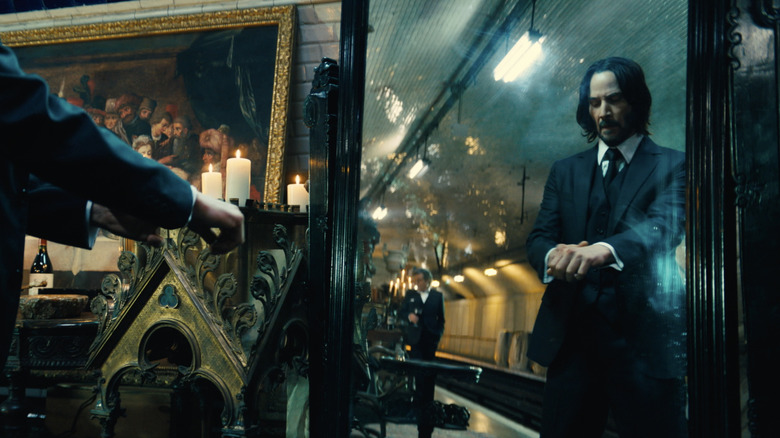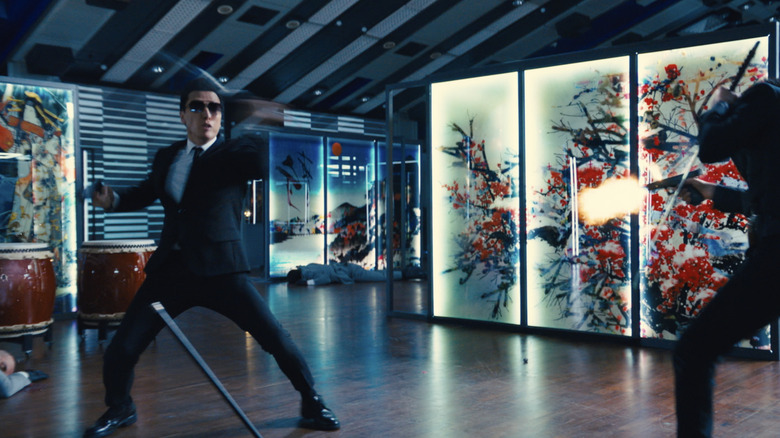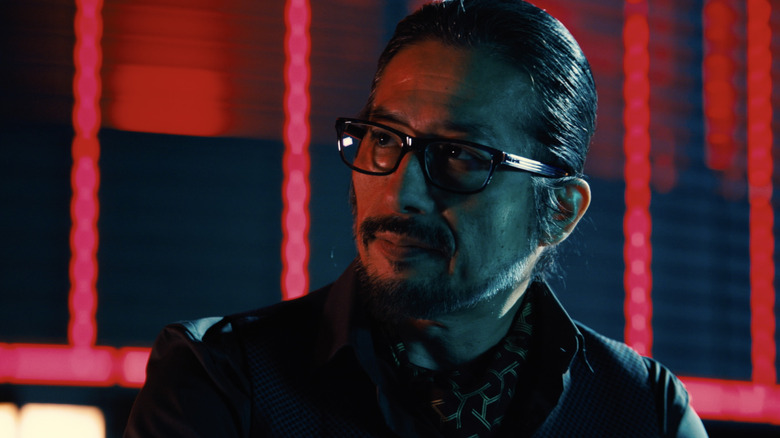Why John Wick: Chapter 4's Color Palette Looks Better Than Ever
Chad Stahelski's "John Wick: Chapter 4," the "Götterdämmerung" of action movies, is a bloody rainbow of visual texture. A lot of the film's photography, by cinematographer Dan Laustsen (a regular collaborator with Guillermo Del Toro) is steely and shiny, taking place in dark clubs, shadowy back rooms, and French streets at night. To distinguish the locales — and the fight scenes — Laustsen carefully expanded the film's color palate, giving each location its own unique motif. This is a common technique for many filmmakers, of course, but it was notably striking in "Chapter 4," given how extreme it was.
Stahelski, in a recent interview with RogerEbert.com, pointed out that he previously had an aversion to reds on screen. Something about the high-contrast colors just didn't look right to him. Looking back to the original "John Wick," one can see what he's talking about. That first movie — indeed the first three movies in the series — consisted mostly of blacks, steely silvers, and muted blues. Even John Wick is typically seen in black or dark-colored suits; he's not the type to rock a teal tux. The red of blood might spray across the screen occasionally, but it was rarely very vibrant, at least in terms of spectrum.
Syahelski's crimson aversion has a lot to do with the kinds of cameras he likes to shoot with. He admits that he was always drawn to Arri brand Alexa cameras, which, according to their website, are particularly good about letting in a great deal of light when filming in large, dark, outdoor spaces. Alexas allow a filmmaker to light a scene using only street lights and the illumination from nearby buildings, producing a dim, shimmering, non-murky night sequence. To Stahelski's eye, this was the desired aesthetic.
Crimson Tide
Thanks to new innovations in Alexas, red was finally on the table. According to Y.M. Cinema Magazine, "John Wick: Chapter 4" was shot using, essentially, IMAX cameras. Laustsen used Arri Alexa AF, and the mini AF variant, equipped with ALFA large format X2 anamorphic lenses. This made the blacks starker, allowing the film's colorist to come in a sweeten up some of the more notable primary colors. As Stahelski said in the RogerEbert.com interview:
"[T]he whole color range on that thing! Like, I've always liked Alexas, I don't know why; they just seem to fit. But we've always had a problem with reds and going big with the highlights and the contrast. You saw what we did in Osaka with all of the reds. The Alexas are great, it crunches the blacks, you can see the range we pushed on this one. We did it at least ten percent bigger than any 'John Wick' film. My colorist, Jill Bogdanowicz, she's probably the best colorist in the world. I love her to death."
Bogdanowizc has worked on dozens and dozens of high-profile Hollywood releases in her 25-year career, offering her services as a colorist on multiple Clint Eastwood movies, several notable studio comedy films, "Godzilla" movies, a "Ghostbusters" movie, "Doctor Sleep," and seven films in the Marvel Cinematic Universe. It is a colorist's job to adjust a film's image, by dyeing or through photographic means, to subtly alter the color in a frame. It was her work, paired with the skill of the D.P. and the now special lenses that Stahelski could finally work in the complete visual spectrum. He said:
"[B]etween [Bogdoanowicz] and Dan Laustsen, we could take the color range so much further, but we couldn't have done it if the Alexa didn't capture it."
Photographic nostalgia
According to the Y.M. Cinema article, "John Wick: Chapter 4" was only the second film ever to be shot using large-format lenses on Alexa cameras. The other was Matt Reeves' 2022 film "The Batman," photographed by Greig Fraser ("Zero Dark Thirty," "Rogue One: A Star Wars Story," "Dune"). In both films, one can see a particular type of hazy dimness that appears to be a rising trend in mainstream Hollywood filmmaking. Many recent photographers are fond of filming areas where light looks like it was only invited into the room begrudgingly. Colors tend to be dark and muted, and images are less sharp and distinct. This may be a contrast from a decade of Marvel movies which, while all employing different cinematographers, tended to skew toward a bright, "clear-line" type of photographic plainness optimized for action clarity. It's a type of photography meant to bring an element of gaudy realism (to employ an oxymoron) into fantastical spaces.
The lenses also allow filmmakers to shoot directly into light sources, allowing a blast halo of white light to accentuate their shapes without falling back on sharp-line silhouettes. Arri Rental put together a demo reel to offer visual examples better than my descriptions. Arri claims that this new anamorphic lens is an enhancement of a certain kind of photography that was in vogue in the 1980s, lending films a nostalgic feeling. Given that Stahelski was born in 1968 and Reeves in 1966, both would have been teens when said trends began. Arri's quest to corner the 1980s nostalgia market seems to be working.
It's certainly more convenient than tracking down vintage cameras and film stocks.


